Connected Logistics Market Size
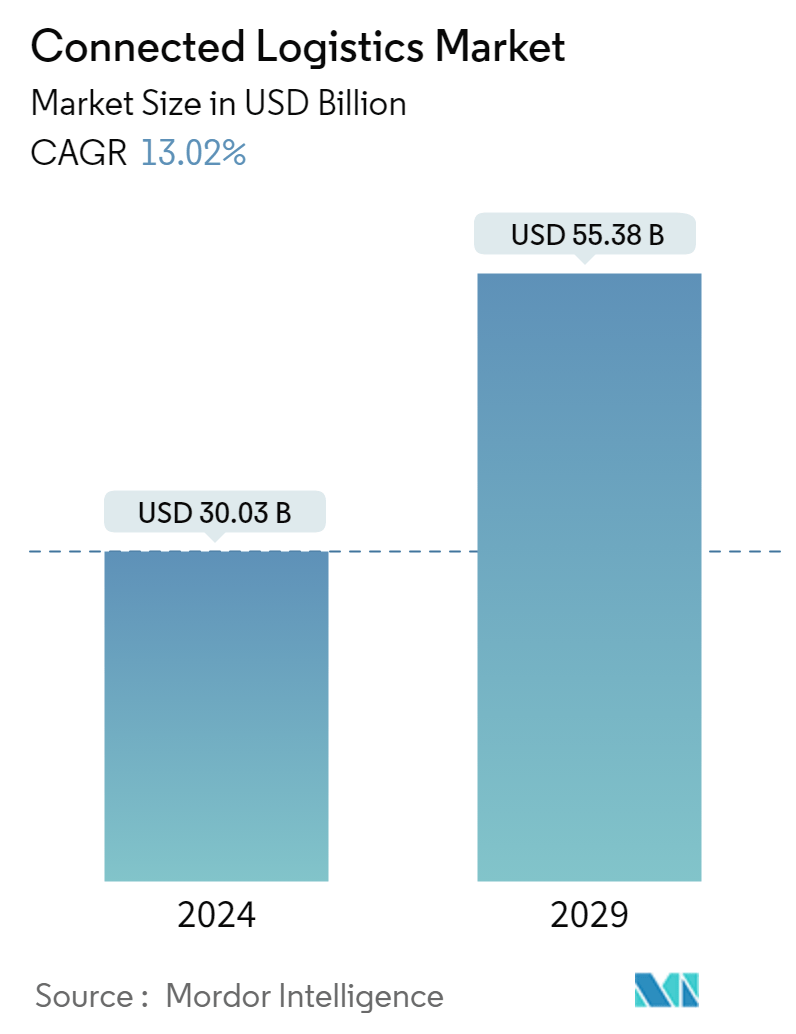
| Study Period | 2019 - 2029 |
| Market Size (2024) | USD 30.03 Billion |
| Market Size (2029) | USD 55.38 Billion |
| CAGR (2024 - 2029) | 13.02 % |
| Fastest Growing Market | Asia Pacific |
| Largest Market | North America |
Major Players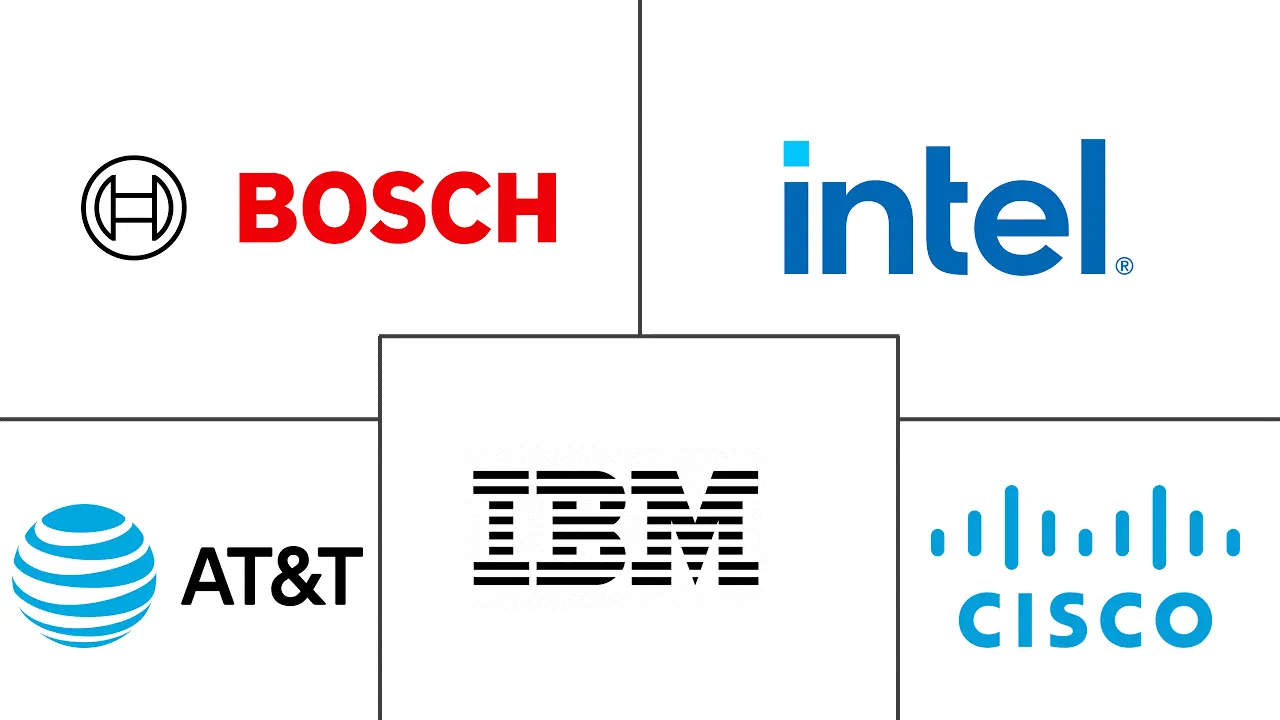
*Disclaimer: Major Players sorted in no particular order |
Connected Logistics Market Analysis
The Connected Logistics Market size is estimated at USD 30.03 billion in 2024, and is expected to reach USD 55.38 billion by 2029, growing at a CAGR of 13.02% during the forecast period (2024-2029).
The connected logistics market is undergoing significant transformation, driven by advancements in technology and the growing need for efficient and real-time supply chain management. This sector is characterized by the integration of IoT, digital platforms, and smart logistics solutions that enhance visibility, optimize operations, and provide seamless connectivity across the supply chain. As industries increasingly adopt connected logistics solutions, the demand for cloud-based logistics, fleet management technology, and predictive analytics in logistics continues to rise.
- Integration of IoT in Logistics: IoT in logistics plays a critical role in enhancing supply chain visibility and efficiency. The integration of IoT devices and sensors enables real-time monitoring of assets, including fleet management technology, crucial for logistics network optimization. These technologies provide accurate and timely data, allowing for better decision-making and reducing the risks associated with supply chain disruptions. The adoption of digital logistics platforms is also on the rise, enabling companies to manage their logistics operations more effectively by leveraging cloud-based logistics solutions and predictive analytics in logistics.
- Adoption Across Various Industries: The market is seeing widespread adoption across various industries such as automotive, manufacturing, and healthcare. These industries benefit from connected logistics systems that enable real-time tracking systems, logistics automation, and telematics in logistics, all of which contribute to enhanced operational efficiency. Furthermore, the implementation of smart logistics and connected freight systems is crucial for achieving end-to-end supply chain integration, which is becoming a priority for companies aiming to stay competitive in the global market.
Expanding IoT Adoption Across Industries
The integration of IoT in logistics has become a critical component for enhancing supply chain visibility and efficiency. IoT devices and sensors enable real-time monitoring of assets, including fleet management technology, which is crucial for logistics network optimization. These technologies provide accurate and timely data, allowing for better decision-making and reducing the risks associated with supply chain disruptions.
- Role of Smart Logistics: Smart logistics, powered by IoT, supports logistics automation and warehouse management systems, leading to reduced operational costs and improved productivity. The adoption of digital logistics platforms is also on the rise, enabling companies to manage their logistics operations more effectively by leveraging cloud-based logistics solutions and predictive analytics in logistics. With IoT adoption expanding, industries are better equipped to achieve real-time tracking and connected freight systems, ensuring a more responsive and agile supply chain.
- Importance in Manufacturing Sector: This trend is particularly noticeable in sectors like manufacturing, where the need for logistics network optimization and seamless supply chain visibility is paramount. The integration of IoT and connected logistics solutions allows manufacturers to maintain a competitive edge through improved efficiency and reduced operational costs.
Adoption of Sensor-Based Technologies
Sensor-based technologies play a crucial role in the connected logistics market by enabling precise and real-time tracking systems. These sensors are integrated into various components of the logistics network, from fleet management technology to warehouse management systems, providing continuous data streams that enhance supply chain visibility.
- Enhancing Efficiency with Sensors: The use of sensors in smart logistics facilitates logistics automation, allowing for more efficient operations and reducing human error. This is particularly important in industries such as automotive and healthcare, where precision and reliability are essential. By incorporating sensor-based technologies, companies can achieve greater control over their logistics processes, from asset management to end-to-end supply chain integration.
- Rising Digital Logistics Platforms: Moreover, the rise of digital logistics platforms has been driven by the need for real-time data and analytics, which are made possible by sensor-based technologies. These platforms enable companies to optimize their logistics network, improving overall efficiency and responsiveness. The integration of predictive analytics in logistics, powered by sensor data, allows for proactive decision-making and risk management, further enhancing the effectiveness of connected logistics solutions.
This connected logistics market analysis highlights the transformative impact of IoT and sensor-based technologies on the industry, emphasizing the importance of real-time tracking, logistics automation, and supply chain visibility for achieving competitive advantage in the market.
Connected Logistics Market Trends
Increasing use of IoT in Various Industries will Drive the Adoption of Connected Logistics
- Increasing Use of IoT in Various Industries :The connected logistics market is increasingly driven by the integration of IoT across various industries. As companies prioritize efficiency and supply chain visibility, IoT in logistics has become crucial for real-time data analytics, enabling smarter decision-making. This trend is particularly evident in sectors like manufacturing, retail, and healthcare, where the demand for logistics automation and real-time tracking systems is surging.
- Telematics and Predictive Analytics: Telematics in logistics, which involves using IoT for fleet management, allows businesses to optimize operations by monitoring vehicle performance and driver behavior. This leads to significant improvements in logistics network operations. Additionally, predictive analytics in logistics enhances the ability to forecast demand fluctuations, thereby reducing delays and ensuring seamless supply chain management.
- Cloud-Based Logistics Platforms: Cloud-based logistics platforms are playing a pivotal role in end-to-end supply chain integration, offering centralized systems to manage various logistics aspects, from warehouse management to connected freight systems. These platforms are critical for enhancing agility and responsiveness in supply chain operations, which is increasingly important in today's fast-paced market environment.
- Shifting to Digital Logistics: The ongoing shift towards digital logistics platforms underscores the industry's move towards automation and connectivity. As businesses continue to invest in connected logistics solutions, the market is poised for substantial growth. This growth is fueled by the rising need for enhanced supply chain visibility and operational efficiency across industries.
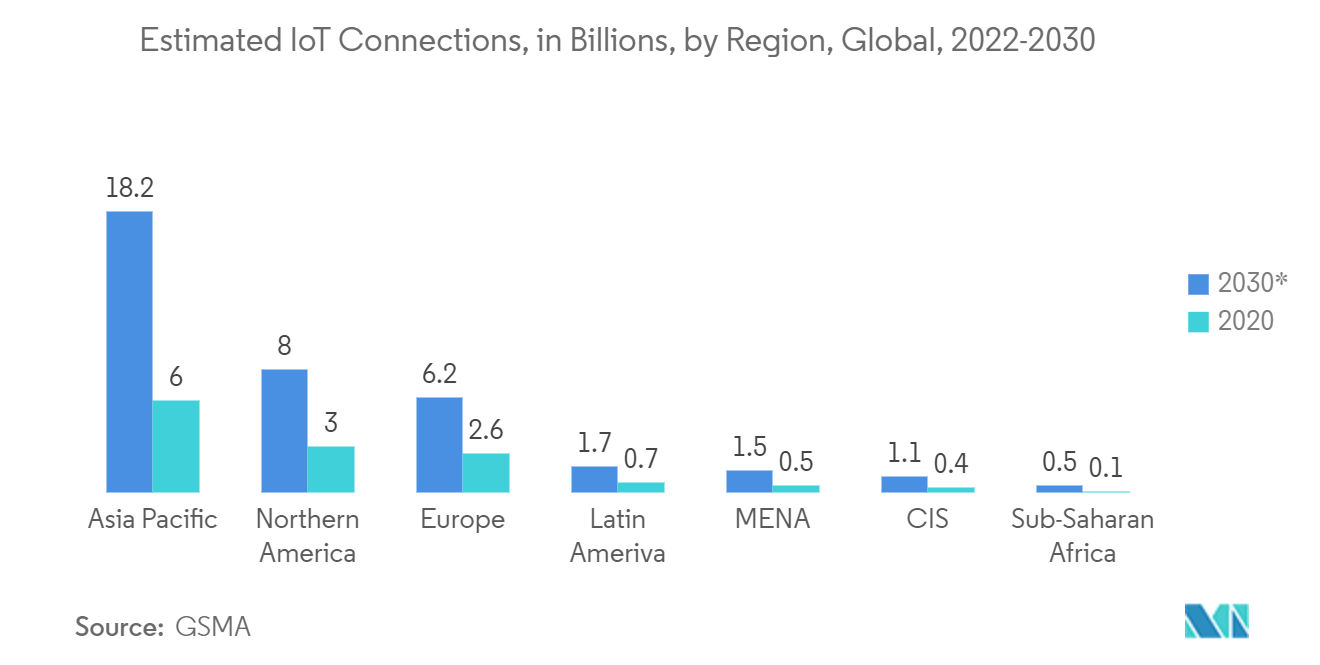
Asia Pacific Region to Exhibit Maximum Growth
- Leading Growth in APAC: The Asia Pacific region is expected to lead in the connected logistics market, driven by economic expansion, technological advancements, and a growing demand for efficient supply chain solutions. Countries such as China, India, and Japan are at the forefront of adopting connected logistics technologies, propelled by their booming e-commerce sectors and vast manufacturing bases.
- Focus on Logistics Optimization: Both governments and private enterprises in Asia Pacific are heavily investing in logistics network optimization. This includes deploying smart logistics systems and real-time tracking systems to manage the region's complex and fragmented supply chains. These efforts are crucial for maintaining efficiency and reliability in supply chains across the region.
- Adoption of IoT and Fleet Management: The increasing adoption of IoT in logistics, along with fleet management and warehouse management systems, is further driving the market in Asia Pacific. These technologies are essential for improving the accuracy and timeliness of deliveries, particularly in countries with large and diverse transportation networks.
- Digital Transformation and Economic Growth: The region is also benefiting from a broader digital transformation, with businesses increasingly digitizing their operations. This shift is supported by government initiatives aimed at promoting advanced technologies. As the region continues to urbanize and its middle class expands, the demand for connected logistics solutions is expected to grow, solidifying Asia Pacific's position as a key player in the global connected logistics market.
By leveraging IoT and other advanced technologies, the connected logistics market is on a strong growth trajectory. The Asia Pacific region, with its robust economic fundamentals and commitment to technological innovation, is set to be at the forefront of this expansion. As industry trends continue to evolve, businesses must adapt by investing in connected logistics solutions to remain competitive in the global market.
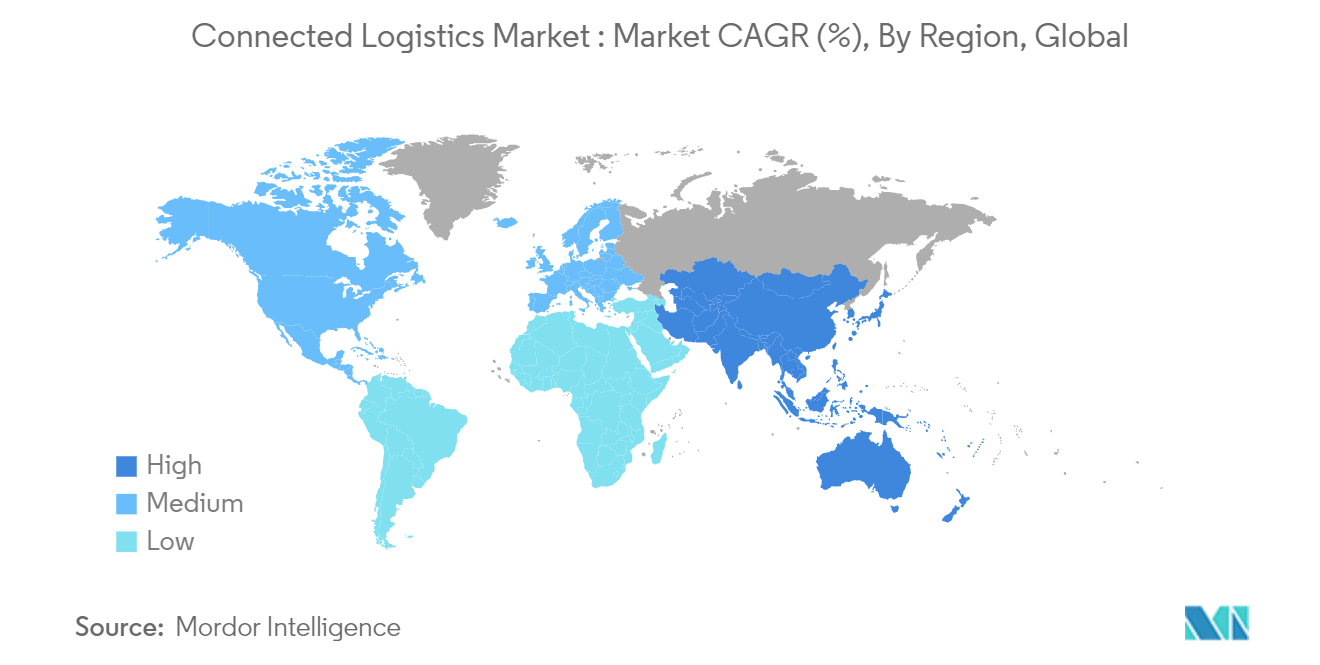
Connected Logistics Industry Overview
Moderately Consolidated Market Dominated by Leading Technology Companies: The Connected Logistics market is characterized by a moderately consolidated landscape, where major global technology companies hold significant influence. Dominance is shared among well-established conglomerates and specialized technology providers, leading to a competitive environment that balances innovation and market control. The presence of multinational corporations underscores the global nature of this market, with a focus on enhancing logistics operations through advanced connectivity solutions.
Key Players Driving Market Innovation: The market's major players include IBM Corporation, Intel Corporation, Robert Bosch GmbH, Cisco Systems, Inc., and AT&T Inc. These companies leverage their extensive expertise in technology, hardware, and software solutions to offer comprehensive logistics services that improve efficiency, reduce costs, and enhance real-time decision-making. Their dominance is largely due to their ability to integrate cutting-edge technologies such as IoT, AI, and cloud computing into logistics systems, thus setting industry standards and securing substantial market shares.
Factors for Future Success: As the Connected Logistics market evolves, trends such as the integration of AI and IoT, the shift towards sustainable logistics, and the growing importance of cybersecurity are becoming pivotal. Companies aiming to succeed in this market must focus on developing solutions that offer greater transparency, security, and adaptability to varying regulatory environments. Additionally, partnerships and strategic acquisitions are expected to be key strategies for maintaining a competitive edge and expanding market presence.
Connected Logistics Market Leaders
-
IBM Corporation
-
Intel Corporation
-
Robert Bosch GmbH
-
Cisco Systems, Inc.
-
AT&T Inc.
*Disclaimer: Major Players sorted in no particular order
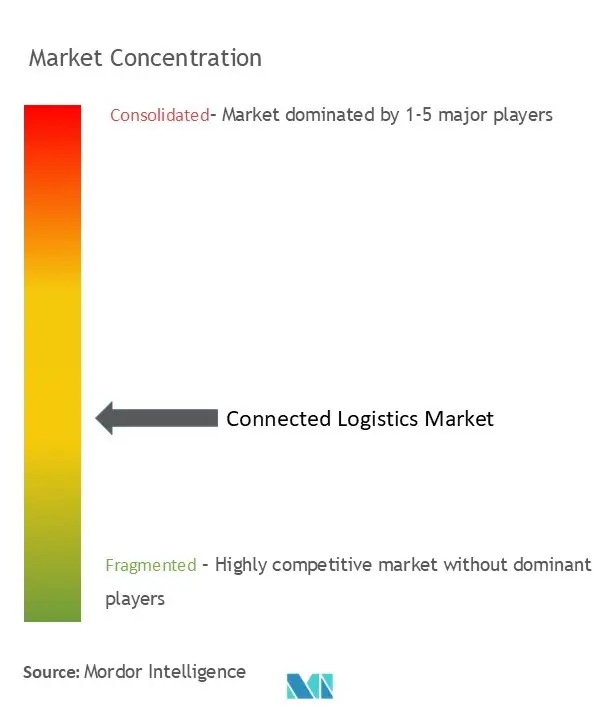
Connected Logistics Market News
- July 2024 - FleetX underscores the significance of a cohesive platform amidst the digital transformation of freight operations. They've developed a singular platform that merges IoT-powered real-time visibility with sophisticated transportation management software. This innovation empowers businesses to monitor their cargo's entire journey and make informed decisions on the spot. By bringing together producers, suppliers, transporters, and clients in a digital realm, FleetX aims to enhance both productivity and decision-making.
- February 2024 - Infosys has announced a strategic partnership with Pacific International Lines (PIL), a leading Singaporean shipping company with strong ties across Asia, Africa, the Middle East, Latin America, and Oceania. The collaboration aims to accelerate PIL's digital transformation initiatives, benefiting key stakeholders in the shipping and logistics industry. This partnership will bolster PIL's mission of 'Driving Connectivity', enhancing connections across its operational markets. Additionally, PIL plans to overhaul its online and mobile platforms, aiming to simplify user interactions and enhance customer engagement.
- January 2024 - Accenture has teamed up with Mujin to establish "Accenture Alpha Automation," a venture targeting the manufacturing and logistics sectors. Through data-driven solutions, Accenture Alpha Automation helps businesses streamline their management infrastructure by merging operational data from manufacturing and logistics with management data.
Connected Logistics Market Report - Table of Contents
1. INTRODUCTION
- 1.1 Study Assumptions and Market Definition
- 1.2 Scope of the Study
2. RESEARCH METHODOLOGY
3. EXECUTIVE SUMMARY
4. MARKET INSIGHTS
- 4.1 Market Overview
- 4.2 Industry Value Chain Analysis
-
4.3 Industry Attractiveness - Porter's Five Forces Analysis
- 4.3.1 Threat of New Entrants
- 4.3.2 Bargaining Power of Buyers/Consumers
- 4.3.3 Bargaining Power of Suppliers
- 4.3.4 Threat of Substitute Products
- 4.3.5 Intensity of Competitive Rivalry
- 4.4 Impact of COVID-19 on the Market
5. MARKET DYNAMICS
-
5.1 Market Drivers
- 5.1.1 Increasing Adoption on IoT in Various Industries
- 5.1.2 Adoption of Sensor Based Technologies
-
5.2 Market Restraints
- 5.2.1 Lack of Uniform Government Regulations for Smart Technologies
- 5.2.2 Coronavirus Outbreak Influencing Electronic Industry
6. MARKET SEGMENTATION
-
6.1 By Software
- 6.1.1 Asset Management
- 6.1.2 Warehouse IoT
- 6.1.3 Security
- 6.1.4 Data Management
- 6.1.5 Network Management
- 6.1.6 Streaming Analytics
-
6.2 By Product Type
- 6.2.1 Device Management
- 6.2.2 Application Management
- 6.2.3 Connectivity Management
-
6.3 By Transportation Mode
- 6.3.1 Roadways
- 6.3.2 Railways
- 6.3.3 Airways
- 6.3.4 Seaways
-
6.4 By End-user Industry
- 6.4.1 Automotive
- 6.4.2 Manufacturing
- 6.4.3 Oil and Gas
- 6.4.4 IT & Telecom
- 6.4.5 Healthcare
- 6.4.6 IT and Telecommunication
- 6.4.7 Retail
- 6.4.8 Food and Beverage
- 6.4.9 Other End-user Industries
-
6.5 By Geography***
- 6.5.1 North America
- 6.5.1.1 United States
- 6.5.1.2 Canada
- 6.5.2 Europe
- 6.5.2.1 United Kingdom
- 6.5.2.2 Germany
- 6.5.2.3 France
- 6.5.3 Asia
- 6.5.3.1 China
- 6.5.3.2 Japan
- 6.5.3.3 India
- 6.5.4 Australia and New Zealand
- 6.5.5 Latin America
- 6.5.6 Middle East and Africa
7. COMPETITIVE LANDSCAPE
-
7.1 Company Profiles*
- 7.1.1 Bosch Service Solutions GmbH
- 7.1.2 Cisco Systems, Inc
- 7.1.3 AT&T Inc.
- 7.1.4 IBM Corporation
- 7.1.5 Intel Corporation
- 7.1.6 SAP SE
- 7.1.7 Oracle Corporation
- 7.1.8 Freightgate Inc.
- 7.1.9 Orbcomm Inc.
- 7.1.10 HCL Technologies Limited
- 7.1.11 Honeywell International Inc.
- 7.1.12 Microsoft Corporation
- 7.1.13 Siemens AG
8. INVESTMENT ANALYSIS
9. FUTURE OF THE MARKET
** Subject To AvailablityConnected Logistics Industry Segmentation
Connected Logistics technology, offered by IoT solution providers, enhances operational efficiency in the logistics sector. These technologies streamline fleet management, tracking, asset oversight, and warehouse operations. Beyond these, they encompass order processing, financial transactions, dispatching, and shipping. By fostering communication among all stakeholders, Connected Logistics not only minimizes emissions and environmental impact but also provides real-time updates on transportation and logistics progress.
The scope of the report covers the different types of connected solutions on the basis of product type and software solutions they offer for a wide range of transportation modes and end-user industries. The study also tracks the key market parameters, underlying growth influencers, and major vendors operating in the industry, which supports the market estimations and growth rates over the forecast period. The study further analyzes the overall impact of COVID-19 on the ecosystem.
The connected logistics market is segmented by software (asset management, warehouse IoT, security, data management, network management, streaming analytics), service (professional services, managed service), transportation mode (roadways, railways, airways, seaways), end-user industries (automotive, manufacturing, oil and gas, IT & telecom, healthcare, IT and telecommunication, retail, food and beverage, other end-user industries) and geography (North America [United States, Canada], Europe [Germany, United Kingdom, France, Rest of Europe], Asia-Pacific [India, China, Japan, Rest of Asia-Pacific], and the rest of the World). The market sizes and forecasts are provided in terms of value (USD) for all the above segments.
| By Software | Asset Management | |
| Warehouse IoT | ||
| Security | ||
| Data Management | ||
| Network Management | ||
| Streaming Analytics | ||
| By Product Type | Device Management | |
| Application Management | ||
| Connectivity Management | ||
| By Transportation Mode | Roadways | |
| Railways | ||
| Airways | ||
| Seaways | ||
| By End-user Industry | Automotive | |
| Manufacturing | ||
| Oil and Gas | ||
| IT & Telecom | ||
| Healthcare | ||
| IT and Telecommunication | ||
| Retail | ||
| Food and Beverage | ||
| Other End-user Industries | ||
| By Geography*** | North America | United States |
| Canada | ||
| By Geography*** | Europe | United Kingdom |
| Germany | ||
| France | ||
| By Geography*** | Asia | China |
| Japan | ||
| India | ||
| By Geography*** | Australia and New Zealand | |
| Latin America | ||
| Middle East and Africa |
Connected Logistics Market Research FAQs
How big is the Connected Logistics Market?
The Connected Logistics Market size is expected to reach USD 30.03 billion in 2024 and grow at a CAGR of 13.02% to reach USD 55.38 billion by 2029.
What is the current Connected Logistics Market size?
In 2024, the Connected Logistics Market size is expected to reach USD 30.03 billion.
Who are the key players in Connected Logistics Market?
IBM Corporation, Intel Corporation, Robert Bosch GmbH, Cisco Systems, Inc. and AT&T Inc. are the major companies operating in the Connected Logistics Market.
Which is the fastest growing region in Connected Logistics Market?
Asia Pacific is estimated to grow at the highest CAGR over the forecast period (2024-2029).
Which region has the biggest share in Connected Logistics Market?
In 2024, the North America accounts for the largest market share in Connected Logistics Market.
What years does this Connected Logistics Market cover, and what was the market size in 2023?
In 2023, the Connected Logistics Market size was estimated at USD 26.12 billion. The report covers the Connected Logistics Market historical market size for years: 2019, 2020, 2021, 2022 and 2023. The report also forecasts the Connected Logistics Market size for years: 2024, 2025, 2026, 2027, 2028 and 2029.
Connected Logistics Industry Report
Our industry research in the connected logistics market provides a comprehensive analysis of current trends, technological advancements, and market dynamics. The report delves into key areas such as the integration of IoT in logistics, smart logistics, and the adoption of digital logistics platforms, which are revolutionizing supply chain visibility and operational efficiency. Through in-depth analysis, the report offers actionable insights into how connected logistics solutions, including real-time tracking systems, fleet management technology, and logistics automation, are driving growth across various sectors. Stakeholders will find valuable industry information and market data, all meticulously compiled in an easy-to-read report pdf format.
This industry report also covers critical aspects such as market forecast, market growth drivers, and the competitive landscape, highlighting the leading players in the connected logistics market. Our detailed industry analysis explores the impact of technologies like predictive analytics in logistics, cloud-based logistics platforms, and end-to-end supply chain integration. These insights are essential for businesses looking to optimize their logistics network and stay ahead in an increasingly competitive market. With a focus on delivering market leaders' strategies, industry trends, and market predictions, our report equips stakeholders with the necessary tools to navigate the evolving connected logistics landscape effectively.
Statistics for the 2024 Connected Logistics Services market share, size and revenue growth rate, created by Mordor Intelligence™ Industry Reports. Connected Logistics Services analysis includes a market forecast outlook to 2029 and historical overview. Get a sample of this industry analysis as a free report PDF download.



